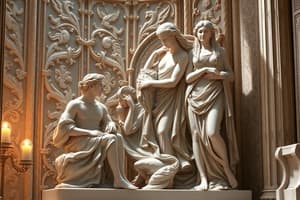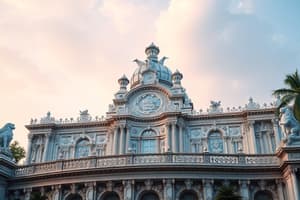Podcast
Questions and Answers
What was the primary purpose of prehistoric sculptures?
What was the primary purpose of prehistoric sculptures?
- To decorate homes and buildings
- To serve ritualistic and religious purposes (correct)
- To display a person's social status
- To tell stories of ancient wars
What material was commonly used in prehistoric sculptures?
What material was commonly used in prehistoric sculptures?
- Glass
- Natural materials such as bone, wood, and stone (correct)
- Metal
- Clay
What was the main feature of ancient Mesopotamian sculptures?
What was the main feature of ancient Mesopotamian sculptures?
- Large-scale sculptures primarily featuring human figures (correct)
- Small-scale sculptures featuring deities
- Large-scale sculptures featuring animal figures
- Abstract sculptures
What was the significance of sculptures in ancient Egyptian culture?
What was the significance of sculptures in ancient Egyptian culture?
What was the characteristic of ancient Egyptian sculptures?
What was the characteristic of ancient Egyptian sculptures?
What was the significance of sculpture in ancient Greek culture?
What was the significance of sculpture in ancient Greek culture?
What was the focus of ancient Greek sculptures?
What was the focus of ancient Greek sculptures?
What can sculptures provide insights into?
What can sculptures provide insights into?
What is the purpose of an armature in sculpting?
What is the purpose of an armature in sculpting?
What is a key characteristic of clay as a sculpting material?
What is a key characteristic of clay as a sculpting material?
What is the primary tool used for carving stone sculptures?
What is the primary tool used for carving stone sculptures?
What is the purpose of refining and detailing in the sculpting process?
What is the purpose of refining and detailing in the sculpting process?
Why is curing or preserving a sculpture important?
Why is curing or preserving a sculpture important?
What is one of the unique characteristics of stone as a sculpting material?
What is one of the unique characteristics of stone as a sculpting material?
What is the purpose of an armature's framework in sculpting?
What is the purpose of an armature's framework in sculpting?
What is a key consideration when exhibiting a sculpture?
What is a key consideration when exhibiting a sculpture?
Why is practice important in the sculpting process?
Why is practice important in the sculpting process?
What is a benefit of using clay as a sculpting material?
What is a benefit of using clay as a sculpting material?
Why is it important to step back and evaluate the sculpture periodically?
Why is it important to step back and evaluate the sculpture periodically?
What period of sculptures evolved into the more natural and realistic Classical period?
What period of sculptures evolved into the more natural and realistic Classical period?
Which famous sculpture is a remarkable example of Roman sculpture?
Which famous sculpture is a remarkable example of Roman sculpture?
What style dominated the Medieval period of sculpture?
What style dominated the Medieval period of sculpture?
Who was a prominent sculptor during the Renaissance period?
Who was a prominent sculptor during the Renaissance period?
What is a key characteristic of Baroque sculpture?
What is a key characteristic of Baroque sculpture?
What was a significant factor in the transformation of sculpture in the Modern and Contemporary period?
What was a significant factor in the transformation of sculpture in the Modern and Contemporary period?
What is the first step in creating a sculpture?
What is the first step in creating a sculpture?
What is a crucial factor to consider when selecting a material for sculpture?
What is a crucial factor to consider when selecting a material for sculpture?
What is essential to have in a sculptor's workspace?
What is essential to have in a sculptor's workspace?
Why is it important to understand the historical context of sculpture?
Why is it important to understand the historical context of sculpture?
What does the term 'papier-mâché' literally mean?
What does the term 'papier-mâché' literally mean?
What is a benefit of using papier-mâché in sculpting?
What is a benefit of using papier-mâché in sculpting?
What is wire sculpting also referred to as?
What is wire sculpting also referred to as?
What is a characteristic of wire sculpting?
What is a characteristic of wire sculpting?
What is a benefit of using plaster in sculpting?
What is a benefit of using plaster in sculpting?
What is found object sculpting also known as?
What is found object sculpting also known as?
What is a benefit of using found objects in sculpting?
What is a benefit of using found objects in sculpting?
What is the first step in stone carving?
What is the first step in stone carving?
Why is it important to prepare the stone before carving?
Why is it important to prepare the stone before carving?
What is a benefit of stone carving?
What is a benefit of stone carving?
What is a characteristic of wood as a sculpting material?
What is a characteristic of wood as a sculpting material?
What is a technique used to create metal sculptures?
What is a technique used to create metal sculptures?
What is a benefit of using polymer clay?
What is a benefit of using polymer clay?
What is a characteristic of mixed media sculptures?
What is a characteristic of mixed media sculptures?
What is terracotta sculpting?
What is terracotta sculpting?
What is wax sculpting also known as?
What is wax sculpting also known as?
What is a benefit of using plaster as a sculpting material?
What is a benefit of using plaster as a sculpting material?
Why is metal a popular material for sculpting?
Why is metal a popular material for sculpting?
What is a characteristic of wood carving tools?
What is a characteristic of wood carving tools?
What is a benefit of experimenting with different sculpting materials?
What is a benefit of experimenting with different sculpting materials?
What technique is effective for roughing out the shape of a sculpture?
What technique is effective for roughing out the shape of a sculpture?
What is the primary purpose of sanding in stone carving?
What is the primary purpose of sanding in stone carving?
What is the final step in bringing out the full potential of a stone carving?
What is the final step in bringing out the full potential of a stone carving?
What is the purpose of using a stone sealer or wax?
What is the purpose of using a stone sealer or wax?
What is the first step in finishing and polishing a stone carving?
What is the first step in finishing and polishing a stone carving?
What is the result of using the pointing technique?
What is the result of using the pointing technique?
What is the purpose of filing in stone carving?
What is the purpose of filing in stone carving?
What is necessary to achieve a successful stone carving?
What is necessary to achieve a successful stone carving?
Flashcards are hidden until you start studying
Study Notes
Historical Evolution of Sculpture
- Sculpture has played a significant role in human creativity and civilization
- Prehistoric sculptures were carved or modeled from natural materials like bone, wood, and stone, serving ritualistic and religious purposes
- Notable examples: Venus of Willendorf, Cave of Altamira's wall paintings
- Ancient Mesopotamian sculptures were monumental, featuring human figures, and adorned temples and palaces
- Notable examples: Code of Hammurabi stele, Winged Bulls of Nineveh
- Ancient Egyptian sculptures served as vessels for the soul in the afterlife, with an emphasis on idealized and rigidly frontal representations of pharaohs, gods, and goddesses
- Notable examples: Great Sphinx, colossal statues of Ramses II
- Ancient Greek sculptures showcased the idealized human form, capturing beauty and essence
- Notable examples: Marble Sculptures from the Parthenon, Winged Victory of Samothrace
- Roman sculptures were realistic depictions of emperors, generals, and mythological figures, conveying power and prestige
- Notable examples: Emperor Augustus of Prima Porta, Column of Trajan
- Medieval sculptures were religious in nature, created for churches and monasteries, with intense expressions and elongated proportions
- Notable examples: Statues on the West Façade of Chartres Cathedral, Pórtico da Gloria at Santiago de Compostela
- Renaissance sculptures reintroduced classical techniques and anatomical accuracy, with masterpieces by Donatello, Michelangelo, and Bernini
- Notable examples: David, Pietà, Apollo and Daphne
- Baroque sculptures emphasized movement, dramatic lighting, and dynamic compositions, with masterpieces by Gian Lorenzo Bernini
- Notable examples: Ecstasy of Saint Teresa, Baldacchino in St. Peter's Basilica
- Modern and contemporary sculpture evolved with industrialization, exploring new materials and techniques, and pushing boundaries of traditional forms
Basic Principles and Techniques of Sculpting
- Conceptualizing your Sculpture: think about the subject, form, and composition, considering the emotions and messages to convey
- Choosing the Right Material: select materials that suit your artistic vision and skill level
- Preparing the Workspace: create a dedicated workspace with necessary tools and materials
- Planning and Armature: create an armature for larger sculptures, sketching out the basic structure and proportions
- Building with Clay: knead and warm the clay, shaping and refining the sculpture with hands and tools
- Carving Stone and Wood: use chisels, mallets, and carving tools to shape and refine the material
- Metal Sculpting Techniques: weld, braze, or assemble found objects to create metal sculptures
- Refining and Detailing: step back periodically to evaluate the composition and balance, refining details as needed
- Curing and Preservation: follow guidelines specific to the chosen material to ensure longevity and stability
- Displaying and Exhibiting: consider lighting, pedestals, and the overall environment for displaying the sculpture
Sculpting Materials and Techniques
- Clay: malleable, versatile, and suitable for beginners
- Stone: requires tools like chisels and hammers, suitable for monumental and durable sculptures
- Wood: versatile, warm, and natural, suitable for carving and shaping
- Metal: strong, durable, and intricate, suitable for welding, brazing, or assembling
- Plaster: versatile, suitable for modeling and casting, and can be combined with other materials
- Polymer Clay: soft, easy to use, and suitable for miniature sculptures and intricate details
- Mixed Media: combines different materials for a unique and visually striking piece
Traditional Sculpting Techniques
- Terracotta Sculpting: works with fired clay, allowing for versatility and affordability
- Wax Sculpting: shapes and manipulates wax to create sculptures, allowing for intricate details
- Papier-mâché Sculpting: mixes paper with a paste to create a lightweight, cost-effective material
- Wire Sculpting: uses wire to create three-dimensional forms, encouraging exploration of dynamic poses
- Plaster Sculpting: works with plaster to create precise details and allow for reproductions
- Found Object Sculpting: repurposes everyday objects to create sculptures with meaning and depth
Studying That Suits You
Use AI to generate personalized quizzes and flashcards to suit your learning preferences.




